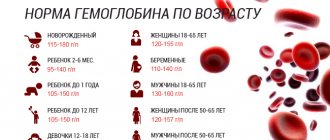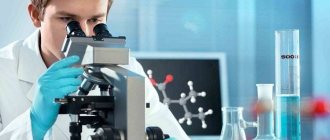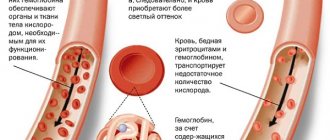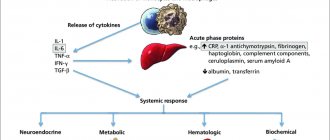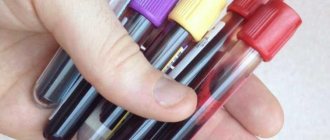From this article you will learn:
- What is anemia
- What are the types of anemia in older people?
- What is the danger of anemia in old age?
- What can cause anemia in old age?
- What are the main symptoms of anemia
- How to cure it in older people
Many people believe that anemia in older people is a mandatory and inevitable phenomenon, but this point of view is not substantiated. However, serious chronic diseases associated with impaired hematopoiesis or blood loss often develop in old age. In addition, there is a lack of substances, the absence of which complicates the formation of red blood cells. All this causes low hemoglobin in the body. How to recognize and successfully treat this pathology in time, why and how does anemia occur in older people? Read about this in our article.
Features of anemia in older people
Hematologists from various countries keep statistics on this disease. According to it, anemia in older people is a very common disease, as it occurs in 40% of elderly people. Signs of pathology include lethargy, weakness, dizziness, pallor, and confusion. If an older person has all of these, they most likely have anemia. The disease manifests itself when hemoglobin and the number of red blood cells in the blood decrease, as a result of which insufficient oxygen enters the tissues and cells of the body. After age 65, the risk of anemia increases. In old age, you should monitor your physical condition even more carefully and get your blood tested, even if, at first glance, there are no health problems.
- In older people, anemia develops in the same way as in representatives of other age categories.
- In elderly patients, the disease occurs due to a lack of iron, vitamin B12 and folic acid in the body.
- Nonspecific manifestations of anemia are masked under the guise of the underlying pathology.
- Due to the disease, cardiovascular diseases are more difficult for older people and people of other ages.
- Treatment of pathology requires an integrated approach.
- Anemia in older people occurs due to inflammatory processes, oncology, and nutritional deficiency.
Mortality and serious deterioration of health from this disease mainly affect patients over the age of 60 years. The disease is often underestimated because there are no clear criteria for its identification. Anemia is diagnosed if hemoglobin is found to be less than 130 g/l in men, below 120 g/l in non-pregnant women and 110 g/l in pregnant women. But these indicators decrease during the aging process, and therefore this pathology in older people is often not treated.
In elderly patients, mortality increases when hemoglobin is below 137 g/l in men and 126 g/l in women. Optimal values should be 140–170 g/l and 130–150 g/l, respectively.
Anemia in older people has serious consequences:
- The likelihood of heart and vascular diseases increases;
- Cognitive impairment occurs;
- Physical performance and quality of life decrease;
- The risk of fractures and falls increases.
If a person is sick with anemia, the length of hospitalization increases, and the risk of dying from pathologies of the heart and blood vessels increases. The disease may also be an early sign of an as yet unidentified malignant tumor.
Anemia occurs:
- iron deficiency;
- iron redistribution;
- sideroachrestic;
- B12 and folate deficiency;
- hemolytic;
- with bone marrow failure;
- with a combined pathogenetic mechanism;
- associated with a decrease in erythrocyte mass.
Read the material on the topic: Hemoglobin in older people: recommendations that will help keep it normal
Diagnosis of anemia and treatment features
In old age, the lower limit of normal hemoglobin level is 110 g/l. A decrease in indicators indicates a mild degree of anemia. If hemoglobin drops to 70-89 g/l, we are talking about moderate severity of the disease. In severe pathology, levels are below 70 g/l. The disease can be diagnosed using a simple blood test.
When prescribing treatment, the doctor takes into account not only research data, but also the patient’s age, his condition, the presence of chronic diseases and other characteristics. At the initial stage, when the indicators are not critical, iron deficiency can be corrected with a special diet. Vitamins, dietary supplements, and a balanced diet for anemia in old age can prevent a lack of beneficial microelements and help improve the patient’s condition.
When it comes to the moderate and severe stages of anemia, diet is no longer enough. Specialized drugs are needed to promote the active formation of hemoglobin and red blood cells in the cells. Medicines are taken according to the regimen prescribed by the doctor. As a rule, during meals: this way, nutrients are better absorbed by the body. Some drugs have side effects: nausea, constipation, abdominal pain. The average duration of treatment is 3-5 months. If necessary, in addition to tablets, intramuscular or intravenous injections are prescribed.
If hemoglobin levels are critical, the question of a blood transfusion may arise. This decision is usually made by a council of doctors.
Causes of anemia in older people
Anemia in older people occurs due to various factors. The causes of this disease, divided into four groups, are as follows:
- Anemia caused by chronic pathologies. This condition appears as a result of certain age-related deviations: infectious, autoimmune, oncology, chronic organ diseases. This type of anemia is usually not very severe and is treated together with the underlying disease.
- Lack of vitamin B12, as a result of which 15% of older people from the total number of patients with this condition develop anemia. B12 deficiency anemia in the elderly is complicated because it is difficult to detect. The main symptoms include weakness and dizziness, and these are often attributed to a heart attack. The problem can only be accurately diagnosed based on a blood test.
- Folic acid deficiency. Occurs when it is insufficiently supplied with food. If the diagnosis is determined accurately, then treating this type of anemia is quite simple: consuming 1 mg of folate per day.
- Iron deficiency anemia in the elderly. Occurs due to iron deficiency, which reduces hemoglobin in elderly patients. Deficiency occurs due to low intake of iron into the body through food or as a result of blood loss.
Iron deficiency anemia is becoming increasingly common in older people.
With this pathology, a low color index of the blood is observed, the concentration of ferritin and serum iron decreases, hypochromia and microcytosis of erythrocytes appear, and the iron-binding property of serum increases. Read material on the topic: Diseases of older people: causes, signs and prevention
Iron distribution anemia
The group of iron distribution anemia includes B12 deficiency and folate deficiency. The first implies insufficient intake of cyanocobalamin from food. After confirming the diagnosis, doctors prescribe a long-term replacement course of 1000 mg intramuscularly until the hemoglobin and red blood cell numbers normalize. After this, the dose is reduced by half, and treatment continues for 2-3 weeks in order to form a vitamin depot. It is important to consider that if such anemia is not treated, then the likelihood of a relapse of the disease. The administration of folic acid is not indicated, since it can provoke the development of neurological problems.
Treatment of folic acid deficiency in anemic syndrome involves the daily use of replacement therapy at a dose of 5 milligrams per day. Severe conditions require parenteral administration of the drug. It can be used for a long time, especially if the patient is diagnosed with hemolysis of unknown origin or tumor processes. Folic acid is used with extreme caution in epileptics, since it can provoke a worsening of the course of this disease.
With a combined course of anemia, doctors resort to complex therapy, prescribing their patients simultaneously preparations of iron, folic acid and vitamin B12.
Symptoms of anemia in older people
What is the characteristic of anemia in older people? The symptoms of this disease are as follows: lethargy, dizziness, weakness, and confusion. Pale skin indicates that the hemoglobin level is low. All these signs together are called anemic syndrome. Anemia, or anemia, is caused by insufficient oxygen supply to the blood. In older people, the risk of getting sick increases, and therefore doctors recommend that people over 65 years of age pay increased attention to their well-being and regularly do a general blood test, regardless of their condition and the presence of signs of abnormalities.
- Recommended articles to read:
- Social services for older people
- Diseases of old age
- Valuable tips on how to choose a boarding house
Signs of anemia
Oxygen starvation leads to deterioration in the functioning of internal organs and systems. This affects your well-being and external symptoms appear:
- fast fatiguability;
- slow pulse;
- dyspnea;
- slow movements;
- bloodless dry skin, yellowish ears when exposed to light, bluish tint to lips;
- inflamed cracks in the corners of the mouth;
- weakened gums, teeth;
- peeling nails;
- lifeless hair;
- depressed mood;
- distorted food interests (chalk, earth).
Treatment of anemia in older people
If it is quite easy for representatives of the young and middle age group to treat anemia, then for older people it is not so simple.
Symptoms of anemia are similar to signs of chronic diseases that the patient has, which makes it difficult to accurately diagnose and begin therapy. Another difficult point: the body of an elderly person is worn out, the functioning of organs and systems can hardly be called ideal. Several causes of anemia have to be treated: protein and iron deficiency, lack of vitamins B9 and B12. The condition will not return to normal until the negative factors are eliminated. It is quite difficult to determine the dosage of medications for elderly people with anemia. Many of them regularly take a range of medications for chronic diseases. Some drugs do not combine well with each other, others enhance or weaken each other's effectiveness. That is why, when prescribing medications, the doctor should take into account many factors so that an overdose does not occur. Based on the cause that caused the anemia, the following treatment is selected:
- If anemia occurs due to iron deficiency, the underlying disease should be treated. Iron supplements act as maintenance therapy. Medicines should be convenient in dosage and affordable. If a patient has poor bowel function, he is prescribed injections and drips. In addition, you should receive 300 mg of iron per day in two doses.
- For folate deficiency anemia, the patient is prescribed a medicine with a high content of folic acid - 5 mg per day. The drug is taken in short courses for hemolysis and tumors. If a person suffers from epilepsy, folic acid is prescribed to him carefully, since it can cause disturbances in the functioning of the nervous system.
- For B12-deficiency anemia, the patient is prescribed a long course of taking the vitamin. At first, it is consumed every day, and after the hemoglobin returns to normal, the condition is maintained in accordance with the doctor’s recommendation. If the pathology is not eliminated, relapses are possible.
Read material on the topic: What does an examination of an elderly person include?
Hemoglobin 60: causes in old age
Reduced hemoglobin – 60, 57, 40 can be observed with:
- blood loss;
- diseases of the stomach, intestines, liver, blood;
- infectious diseases, oncology;
- poor absorption of certain nutrients by the body or fasting;
- stress;
- physical inactivity.
Vegetarianism and strict diets exclude protein and iron-containing foods - meat, liver, kidneys. Adherents of this type of diet are primarily at risk. Anemia affects people who are hungry due to difficult social conditions.
Blood loss will show hemoglobin 60 in women after surgery, uterine, traumatic bleeding. This also includes hidden hemorrhages, the cause of which is ulcers and hemorrhoids.
In addition, ulcers in the stomach and intestines, gastritis, duodenitis limit and slow down digestion, and at the same time the absorption of iron, vitamins C, B 12, and folic acid.
Hepatitis, tuberculosis, cancer, systemic diseases (lupus erythematosus) destroy hemoglobin. Infection with worms significantly reduces the level of red blood cells, as the parasites feed on blood. Physical inactivity, including in bedridden patients and older people, worsens hemoglobin synthesis and slows blood circulation. Tension of the nervous system due to stress worsens appetite and limits the supply of iron from foods.
A low red blood cell count in women aged sixty or older is dangerous. It directly affects life expectancy, since oxygen starvation is superimposed on age-related changes in the heart, blood vessels, brain, and nervous system. The risk of multiple sclerosis increases. It is difficult for the body to resist colds and infectious diseases.
The compensatory mechanisms of an elderly woman are already working at a minimum level. Mild anemia quickly progresses to a stage when hemoglobin is too low - 56, 50.
At retirement age, the hemoglobin concentration is considered normal in the range of 114-160 g/l. There are no exceptions to these rates since menopause does not cause loss due to menstruation every month. A mature person should take any deviations from the norm seriously and immediately do tests to identify the root cause.
Why does low hemoglobin plague almost a third of the world's population? The main causes of this problem are poor, unbalanced nutrition and certain types of diseases.
- excessive presence of stressful situations;
- frequent diets or vegetarianism;
- hormonal imbalance of the thyroid gland;
- large blood loss (during operations, childbirth, menstruation);
- the presence of gastritis, peptic ulcers of the intestines or stomach and other diseases of the gastrointestinal tract;
- death of red blood cells (in infectious and autoimmune diseases);
- malignant blood diseases.
- diseases of the gastrointestinal tract;
- lack of fresh air and excessive power loads;
- slagging of the body and poor absorption of essential vitamins and minerals;
- blood poisoning or the onset of cancer;
- excessive loss of blood or lack of time to restore the required amount (for example, with frequent donations).
- premature removal of the placenta or possible rupture of the umbilical cord indicates a large loss of blood;
- irregular shape (slightly or not at all spherical) of red blood cells leads to the rapid breakdown of hemoglobin - spherocytosis, transmitted hereditarily;
- in children who were born 1-2 months earlier, the bone marrow does not keep up with protein renewal, and the breakdown of red blood cells occurs too quickly;
- also, the rapid breakdown of red blood cells often includes an intrauterine infection that the mother did not cure before conception or in its early stages;
- lack of a normal amount of iron, which should be supplied with food both during breastfeeding and artificial feeding (this can happen up to 6 months).
- with malnutrition, which brings the necessary vitamins and minerals;
- an unhealthy lifestyle (lack of sufficient fresh air, an active sports lifestyle) indicates a metabolic disorder;
- large blood loss (both internal and external);
- impaired production of red blood cells (this is due to the absence or deficiency of folic acid or vitamin B12).
What to do with low hemoglobin depends on the causes of this problem. To find out, you need to see a doctor, take the necessary tests and complete blood count.
Why is low hemoglobin dangerous? In addition to the above symptoms, which affect a person’s internal health and appearance, there are certain consequences of low hemoglobin that lead to the following diseases:
- problems with the immune system lead to complications in any disease, even the common cold;
- low hemoglobin in women during pregnancy can lead to loss of tone and contractility of the uterus, incorrect location of the placenta, delay or even cessation of fetal development;
- the fetus may have problems with the respiratory system, deviations in physical or mental development, and complete depletion of muscles and organs.
Iron deficiency is the most common cause of low hemoglobin in people. But there are other reasons, more serious factors that lead to a decrease in hemoglobin content in the blood. These include:
- Lack of necessary enzymes - it happens that everything is fine with iron in food, but there are no substances that help digest food. In addition to extracting the ferrum (this in itself is not easy), you also need to create the molecule, which is very difficult due to the complexity of its chemical structure. For a successful reaction, the body must have vitamins B (there are many of them in meat), C and PP. The most important substance required for the synthesis of the main oxygen transporter is folic acid, known as vitamin B9.
- Diseases of the digestive tract (GIT) - if a person has problems with the liver or stomach, then it is natural that the necessary enzymes will not be produced in the required quantities. At the same time, remember: everything is interconnected. Therefore, a lack of folic acid can also cause gastrointestinal diseases.
- Natural decrease in enzyme activity in older people (after 50-60 years). However, this does not mean that it is impossible to bring the required hemoglobin levels back to normal.
- Parasites in the body - people with tapeworms may have 30% less protein than needed. This is one of the main causes of iron deficiency anemia. Parasites arise because they adore folic acid.
- Kidney disease and cirrhosis of the liver - these diseases interfere with the removal of the hormone erythropoietin from the body, which also disrupts the functioning of the body. As a result, a drop in red blood cells may occur. Kidney diseases and liver cirrhosis are combined into one group, because often liver cirrhosis in women or men provokes kidney failure.
- Bone marrow dysfunction. Its job is to create erythrocytes (red blood cells). If there are fewer of them, then the hemoglobin content will naturally fall. After all, it is red blood cells that transport oxygen.
- Internal bleeding can be caused by anything, from a stomach ulcer to rupture of small blood vessels. So low hemoglobin may indicate internal bleeding.
If there is a lot of carbon monoxide, there will be less “working hemoglobin”, part of it is blocked. The effect is the same as with a reduced content of molecules transporting oxygen. This is the main danger: chronic oxygen starvation (hypoxia) occurs, which affects all organs. If hypoxia is prolonged, the body gradually dies.
With a low hemoglobin content in the blood, anemia occurs (a group of clinical and hematological syndromes), all body functions suffer, starting with mental processes (it becomes difficult to concentrate, drowsiness appears) and ending with dysfunction of the gastrointestinal tract and immune system.
Reduced oxygen levels in the body can trigger ischemic heart attack and stroke, and if the amount of this important protein is constantly decreasing, this is a serious reason to think about it. Doctors advise you to be examined several times over a certain period of time so that you can determine the trend.
Hemoglobin norm in elderly women and men
In a person in adulthood, the normal concentration of hemoglobin depends on gender, living conditions, and number of years. For example: for women, the norm is considered to be a hemoglobin content of 115 to 140 grams per liter, and for men – from 125 to 150 grams per liter.
Hemoglobin norm
When a person reaches old age, doctors allow a drop in hemoglobin of 5 grams per liter, this should not cause concern on the part of patients, such a decrease is natural.
For people living in mountainous areas, active athletes, and those who constantly experience physical stress at work, a high hemoglobin level in the blood is taken as the norm. A relative increase in the standard is also natural for those who smoke for a long time.
Maintaining a normal hemoglobin level in an adult is an important condition for excellent health and well-being. If there are deviations, then unpleasant consequences will appear. For example: when anemia just begins to develop, the amount of hemoglobin in the blood is reduced insignificantly for a short period of time, rapid fatigue and shortness of breath appear, the pulse quickens, appetite worsens, and insomnia is possible. As soon as such symptoms appear, it is important to immediately take a blood test to determine hemoglobin levels. If abnormalities are found, you must consult a doctor and take action. Sometimes you have to think about how to urgently increase the hemoglobin level at home for an elderly person.
Drugs
Today there are drugs to increase iron in the blood that are well tolerated by the body of older people. The dosage and frequency of use should be determined by a doctor. Such medicines include: Ferrum lek, Ferratab, Totema, Hemobin, Hemofer, Maltofera.
Most often, doctors recommend Hemobin, since it has virtually no side effects and can quickly improve the patient’s condition. At the same time, drugs produced in liquid form are absorbed by the body better and quickly increase the level of hemoglobin in the blood.
More than half of people over 60 years of age experience a decrease in hemoglobin to 110 g per liter of blood or lower. Previously, doctors believed that this was a feature of the body of the elderly, but today this hypothesis has been recognized as incorrect. Hematopoiesis in the body of people of all ages is almost the same, and hemoglobin in the elderly may not be lower than in middle-aged people. Therefore, at any age, you can increase your hemoglobin level to a sufficient level.
Introduction
According to the United Nations, as of 2020, there were more than 703 million people aged 65 years and older in the world.
By 2050, this figure will increase to 1.5 billion [1]. Elderly and senile people (according to the World Health Organization age classification - people aged 60 to 75 and 75 to 90 years, respectively) make up the majority of outpatients and inpatients. To reduce healthcare costs, reduce the number of doctor visits and home observations, as well as planned and emergency hospitalizations in the elderly and senile, it is necessary to determine the optimal approach to the treatment of chronic diseases. However, the quality of life of elderly and senile patients, as well as the prognosis for life and health, are determined not so much by the presence of chronic diseases, but by the presence and severity of geriatric syndromes. Geriatric syndrome is a multifactorial, age-associated clinical condition that impairs quality of life and increases the risk of adverse outcomes and functional impairment. Geriatric syndrome is considered not as a manifestation of the pathology of one organ or body system, but as a reflection of a complex of changes in several body systems [2]. One of the reasons for the worsening of the course of diseases in gerontological patients is anemia. Elderly and senile patients suffering from cardiovascular diseases are sensitive to the slightest decrease in hemoglobin (Hb) levels and disorders of iron metabolism. The circulatory hypoxia that occurs during anemia leads to increased sympathetic activity and increased cardiac output, which cause left ventricular hypertrophy. Iron deficiency contributes to the development of heart failure and myocardial fibrosis, in addition, it is associated with thrombocytosis, which leads to the progression of thrombus formation [3].
Reduced hemoglobin
Low hemoglobin levels are often observed at different ages - both young and old.
Causes and symptoms
A lack of hemoglobin occurs when the body loses a large amount of it or receives little.
The main causes of low hemoglobin in older people:
• Monotonous food. Hemoglobin synthesis occurs thanks to foods containing iron, B vitamins, amino acids and food acids. If the diet lacks these substances, a person's hemoglobin level is reduced. A poor diet leads to a lack of this protein. For the same reason, low hemoglobin occurs in vegetarians. • Internal bleeding can cause hemoglobin deficiency. Women may experience gynecological bleeding. In men, various internal bleeding is possible: stomach, intestinal, kidney, nasal. Frequent blood loss leads to a lack of hemoglobin. • Severe infection • Chronic enteritis • Long-term use of IV drips • Excessive drinking
A reduced level of hemoglobin is associated with various disorders and internal problems in the human body.
If the level of this protein decreases without obvious reasons, examination by specialists is necessary. Low hemoglobin levels are a symptom of such problems, so the root cause needs to be identified and addressed. If you increase hemoglobin without finding out the root cause, it will return to normal only for a certain time.
Symptoms of low hemoglobin are the same for people of any age:
• dry skin • loss of strength and weakness • fatigue • dizziness • shortness of breath • palpitations
Anemia is a pathological condition that develops when hemoglobin decreases to less than 110 g per 1 liter. It occurs in almost half of people over 60 years of age. The development of anemia has nothing to do with age-related changes in the body: in a healthy pensioner, the blood functions in the same way as in a middle-aged person.
The appearance of anemia is influenced by diseases: frequent tumors, infections, diseases of the heart, autoimmune or endocrine systems, chronic illnesses. Such problems cause a decrease in hemoglobin levels, and its deficiency further aggravates the situation.
At the very beginning of the development of anemia, tests may be normal, but anemia already manifests itself in the first signs. Look out for these common symptoms of anemia:
• Dryness and paleness of the skin • The appearance of painful cracks in the corners of the mouth • Brittle and pale nails • Burning sensation and pain in the tongue • Brittleness and hair loss
Other additional signs of anemia subsequently develop:
• Fatigue, lethargy • Rapid breathing and pulse • Tinnitus • Frequent dizziness • Muscle weakness • Spots in the eyes • Difficulty concentrating • Fever • Irritability
At the beginning, there may be no symptoms or only dizziness and lethargy. With a further decrease in hemoglobin, these symptoms become more pronounced. With a large lack of hemoglobin, a person’s thoughts become confused and fainting is possible.
If a person discovers signs of anemia, he needs to go to the doctor for diagnosis and subsequent treatment. Treatment for anemia depends on its type. There are several types of disease. Let's look at them in order.
Types of Anemia
There are different types of anemia. In older people, four types are more common, which we discuss below.
• Anemia of chronic diseases (ACD)
It occurs due to many diseases: infections, autoimmune diseases, tumors and others. Anemia is not severe and is a symptom of an underlying chronic illness. Treatment is carried out by resolving the underlying problem. Iron supplements will not help with ACD.
• Iron deficiency anemia (IDA)
The most popular type. Occurs due to a lack of iron due to poor nutrition or blood loss due to internal bleeding. Characterized by a drop in iron levels and a less saturated color of the blood.
Bleeding is caused by internal diseases: gastric or duodenal ulcers, gastritis, intestinal angiodysplasia, diverticulosis, cancer. The development of IDA is also affected by chronic bleeding of the genitourinary system, bleeding disorders, stomach ulcers, colitis, Crohn's disease, tumors and others.
Iron-containing preparations are used in treatment. The main means for increasing hemoglobin are ferrous sulfate and ferrous gluconate. The medications are taken 3-4 times a day.
For better absorption of iron, vitamin C is recommended. Calcium, coffee, tea and wine interfere with the absorption of iron, so they should not be mixed in the same meal with medications and foods containing iron.
• Anemia caused by lack of folic acid
Folic acid deficiency is usually associated with poor diet. To replenish its reserves, appropriate medications and healthy nutrition are prescribed.
• Anemia due to lack of vitamin B12
Neurological signs appear before the symptoms of anemia: decreased sensitivity, muscle weakness, hyporeflexia. Then spasms and ataxia may develop.
The cause of this anemia is a decrease in intestinal absorption of vitamin B12. B12 deficiency can be observed in the following cases: gastric resection, diseases of the small intestine, vegetarianism. Vitamin B12 deficiency is treated by replacing it with medications.
Anemia in older people can be cured if treatment is started on time and all medical recommendations are followed.
Anemia is dangerous for older people and can lead to complications and serious consequences. Due to a lack of hemoglobin, immunity decreases, so a person becomes vulnerable to various viruses and infections.
If anemia is started, a severe lack of hemoglobin may develop, which will lead to health problems. At the third, severe stage of anemia, a person develops tachycardia, bradycardia, blood pressure increases, muscle atony, and fainting occur. Lack of hemoglobin leads to oxygen starvation of the brain, which can cause the development of Alzheimer's disease.
Anemia must be treated immediately, since in older people it quickly turns into chronic anemia. Women may develop tumors of the reproductive system, and men may develop dementia praecox. Anemia is three times more common in older men than in women. All retirees are advised to have regular blood tests to check and detect problems early on.
Diagnostics
If symptoms of anemia appear, a blood test should be done. This informative method helps the specialist determine the number of red blood cells, hemoglobin level, and the degree of anemia.
Anemia caused by a lack of folic acid or vitamin B12 is diagnosed in a differential manner.
They investigate the root cause of anemia and pay attention to chronic diseases. After a detailed diagnosis, suitable treatment is prescribed.
Treatment
Therapy is based on the following plan:
• Getting rid of the cause of anemia • Maintaining a healthy daily routine and maintaining a complete harmonious diet • Regular intake of iron supplements • Monitoring blood counts to prevent the risks of iron deficiency anemia
Treatment for low hemoglobin depends on the type of anemia.
With iron deficiency anemia, the amount of ferritin and serum iron in the blood decreases, and the iron-binding capacity of the blood increases. With IDA, the number of red blood cells in the blood decreases.
To get rid of anemia, you need to treat the root cause. For auxiliary treatment, iron-containing drugs are prescribed.
To raise iron levels to normal levels per day, a dosage of 150-300 mg of an iron-containing product is required 1-2 times a day. Typically, medications based on ferrous sulfate or fumarate are prescribed. It is better to take the product with food for better absorption.
It is necessary to carefully observe the dosage of medications, since drugs with iron can lead to side effects: disruption of the healthy functioning of the stomach, nausea and vomiting, constipation, vascular inflammation, allergies, hypotension, and chest pain. You cannot prescribe medications for yourself - the medications are prescribed by your treating specialist.
Means for increasing hemoglobin in the elderly must meet certain criteria:
• Contain sufficient amounts of ferrous iron. • Iron must be well absorbed - for this purpose special components are added to medications. • Dosages and use of drugs should be convenient for pensioners. • Funds must be affordable.
Iron levels can be increased through appropriate nutrition. You need to include foods rich in iron in your diet and combine them with medications.
Anemia due to deficiency of folic acid and B12 is characterized by a more saturated shade of blood. Red blood cells increase in size. There is a decrease in leukocytes and platelets, and the amount of iron in the blood serum increases. A person experiences neurological and mental disorders.
The causes of this anemia are:
• Gastritis, stomach cancer • Pancreatitis, diverticulosis • Inflammation of the small intestine • Dysbacteriosis • Chronic hepatitis
Anemia can be caused by improper use of medications or a lack of important substances in the body.
Bone marrow analysis is used in diagnosis. The person is also checked through research: a course of vitamin B12 is prescribed and the patient’s blood condition is monitored. If a person gets better and his blood counts return to normal, it means he has anemia due to a lack of B12.
Treatment is carried out with vitamins. Vitamin injections are given daily until blood counts return to normal. Next, to consolidate the result, vitamins are administered 1-2 times a month.
Anemia due to a lack of folic acid occurs less frequently for the following reasons:
• Frequent alcohol intoxication • Destruction of red blood cells, oncology, dermatitis, enteritis • Nutritional deficiency • Taking certain medications
In treatment, you need to pay attention to the root cause of anemia. If it cannot be eliminated, the person is treated with vitamins. The patient is prescribed folic acid injections or tablets at a dosage of 5 mg per day.
To quickly increase hemoglobin in an elderly person, suitable medications are prescribed. The medications prescribed vary depending on the type of anemia, concomitant diseases, and the condition of the elderly. For example, Hemobin is often prescribed. This remedy is well suited for older people, and its only contraindication is individual intolerance.
Elderly people are prescribed medications in tablet and liquid form for easier and better absorption.
Nutrition and traditional medicine for low hemoglobin
Hemoglobin in the body of an elderly person is produced thanks to foods rich in vitamin B, iron, amino acids and other food acids.
A suitable diet must be combined with medication. In the future, after recovery, you should adhere to a healthy diet to maintain normal hemoglobin. Folk recipes also provide nutritional recommendations for anemia and offer healthy herbal recipes.
Nutrition rules:
• Small meals 5-6 times a day. The last meal is at least 3 hours before going to bed. • Replace coffee and tea with herbal teas, vegetable and fruit juices. • Walk in the fresh air more often to normalize oxygen balance and stimulate hemoglobin renewal.
To increase hemoglobin levels, you need to introduce iron-rich foods into your diet. These include:
• Meat, meat by-products, fish • Egg yolks • Food made from whole grain flour • Nuts and seeds • Porcini mushrooms • Buckwheat, lentils, beans • Wheat germs and sprouts • Beets, carrots, cabbage, seaweed, greens (parsley, spinach, fennel) • Prunes, apricots, dates, figs, black currants • Strawberries, currants, pomegranate, yellow and orange fruits • Herbs, seasonings • Decoction of nettles and rose hips • Dried fruits, chocolate, halva, natural dark honey
Folk recipes and useful nutritional recommendations:
• There are soups made from rye and wheat bran. • Drink juice from pickled beets - 200 ml per day. • Nettle decoction or tincture – take 20-25 g before bed. • It is useful to eat carrots, apples and parsley. • Dried apricots are an excellent dried fruit for increasing hemoglobin. You should eat seedless in small quantities every day. • Drink whole milk.
Several recipes to increase hemoglobin:
• Decoction of meadow clover. Pour clover heads (10 g) with a glass of water and brew, strain after 45 minutes. Take 3 times a day, two tbsp. l. • Rosehip infusion. Pour one tbsp. l. rosehip berries with one glass of boiling water and leave to infuse for several hours. You can drink it instead of tea three times a day. • Vegetable juice. Peel and wash the beets, carrots and black radishes. Finely grate and squeeze the juice from each vegetable. Mix in equal parts and place in the oven for 3 hours. Then take the product one tbsp. l. in a day.
When choosing a traditional recipe, consult your doctor. You need to eat harmoniously and fully, be sure to have breakfast, lunch and dinner. The diet should be higher in calories in the first half of the day, and it is better to have a light dinner. Along with meals, you can use suitable folk remedies, for example, teas or decoctions.
Natural juices are very useful for increasing hemoglobin and are well absorbed. The following juices are suitable for anemia:
• Pomegranate. It is diluted a little with boiled water. Consume three times a day half an hour before meals every day for 2-3 months. • Birch. You can drink in large quantities - up to 4 glasses a day. It will protect against fatigue. • Beetroot. It is recommended to drink 100 ml of fresh juice daily for a month. • Carrot-spinach mixture. It is recommended to drink 100 ml three times a day. • Juice from dandelion leaves. Drink 50 grams once a day for a long time.
If you have anemia, you should not starve, overeat, or take long breaks between meals. Portions should be hearty and moderate.
In old age, you should not get carried away with interesting nutritional systems and varied diets - it is better to eat a nutritious diet and follow healthy recommendations.
If a person has lost teeth or they are in poor condition, this must be taken into account when preparing food. Food should be prepared soft so that it is easy to chew, and liquid dishes should be used. You can use a blender or grater to grind food.
With the help of suitable nutrition, anemia can be eliminated at an early stage of development. By combining nutrition and traditional medicine over a long period of time, it is possible to normalize hemoglobin levels in a short time. After a month, it is recommended to take a blood test to check. If hemoglobin is not yet normal, treatment is continued.
How to raise hemoglobin levels: useful tips
You need to lead a healthy lifestyle. Healthy recommendations include:
• High-quality nutrition - several times a day. A varied healthy diet, including all useful vitamins and substances. • Give up vegetarianism and bad habits. • Treat diseases in a timely manner, maintain normal condition in case of chronic illnesses.
In old age, you need to be prepared for long-term treatment due to the health status of the elderly person. With a competent approach, the symptoms of anemia gradually go away, and the person begins to feel better.
